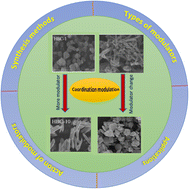Coordination modulation: a way to improve the properties of metal–organic frameworks
Abstract
Metal–organic frameworks (MOFs) are highly valuable hybrid materials that have drawn significant research attention. One reason for such attractiveness is the designability of their important porosity features such as surface area, surface chemistry, pore shape, size, and size distribution. The coordination modulation method provides a useful way to further modify the porosity, size and shape of MOFs, whereby modulators act as guiding agents during the MOF synthesis. In this review, we discuss coordination modulation with various types of modulators, synthesis techniques, the action of modulators, as well as the effect of modulators on the properties of the modulated MOFs and their application.

- This article is part of the themed collection: Journal of Materials Chemistry A Recent Review Articles


 Please wait while we load your content...
Please wait while we load your content...